Jin Bai
MCFEND: A Multi-source Benchmark Dataset for Chinese Fake News Detection
Mar 14, 2024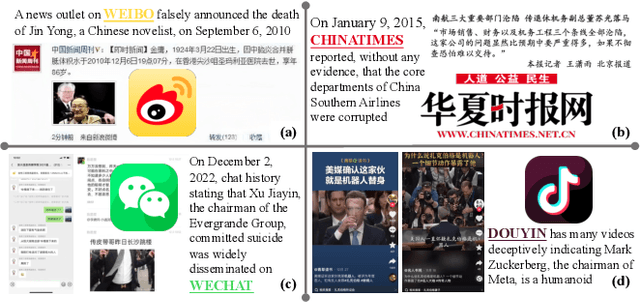
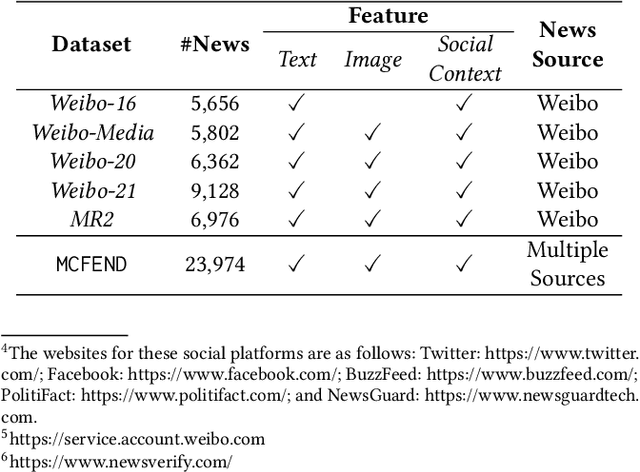
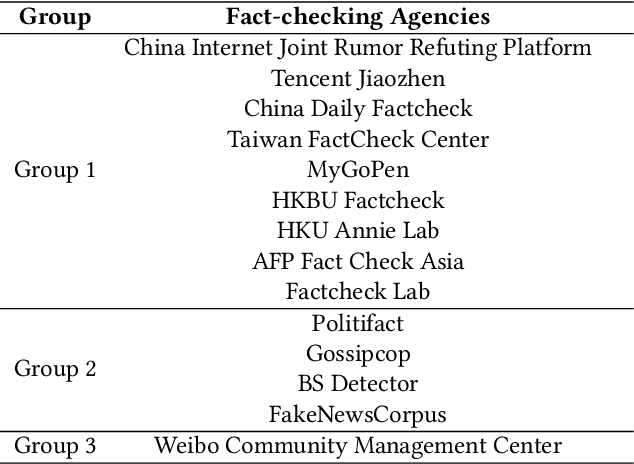

Abstract:The prevalence of fake news across various online sources has had a significant influence on the public. Existing Chinese fake news detection datasets are limited to news sourced solely from Weibo. However, fake news originating from multiple sources exhibits diversity in various aspects, including its content and social context. Methods trained on purely one single news source can hardly be applicable to real-world scenarios. Our pilot experiment demonstrates that the F1 score of the state-of-the-art method that learns from a large Chinese fake news detection dataset, Weibo-21, drops significantly from 0.943 to 0.470 when the test data is changed to multi-source news data, failing to identify more than one-third of the multi-source fake news. To address this limitation, we constructed the first multi-source benchmark dataset for Chinese fake news detection, termed MCFEND, which is composed of news we collected from diverse sources such as social platforms, messaging apps, and traditional online news outlets. Notably, such news has been fact-checked by 14 authoritative fact-checking agencies worldwide. In addition, various existing Chinese fake news detection methods are thoroughly evaluated on our proposed dataset in cross-source, multi-source, and unseen source ways. MCFEND, as a benchmark dataset, aims to advance Chinese fake news detection approaches in real-world scenarios.
Novel models for fatigue life prediction under wideband random loads based on machine learning
Nov 13, 2023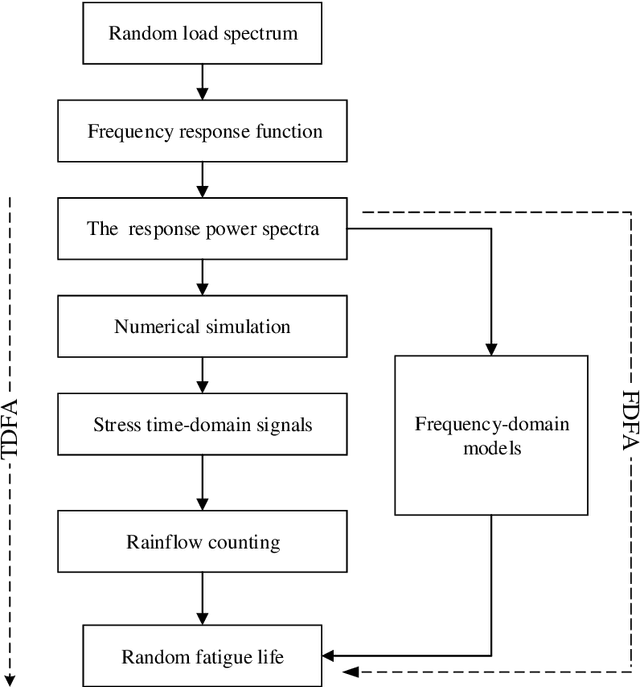

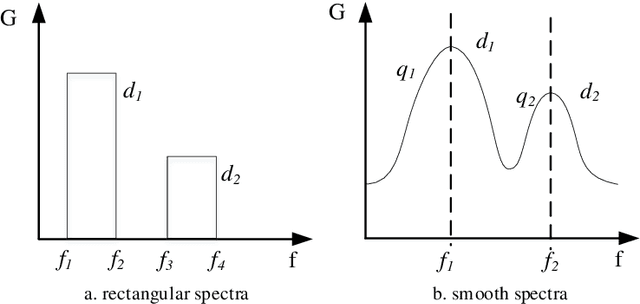
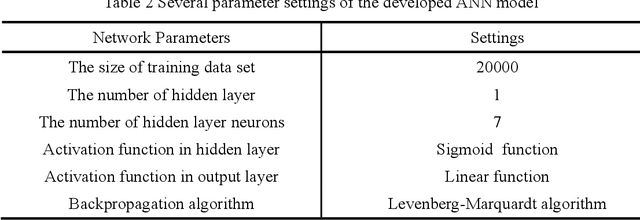
Abstract:Machine learning as a data-driven solution has been widely applied in the field of fatigue lifetime prediction. In this paper, three models for wideband fatigue life prediction are built based on three machine learning models, i.e. support vector machine (SVM), Gaussian process regression (GPR) and artificial neural network (ANN). The generalization ability of the models is enhanced by employing numerous power spectra samples with different bandwidth parameters and a variety of material properties related to fatigue life. Sufficient Monte Carlo numerical simulations demonstrate that the newly developed machine learning models are superior to the traditional frequency-domain models in terms of life prediction accuracy and the ANN model has the best overall performance among the three developed machine learning models.
Automatic Procurement Fraud Detection with Machine Learning
Apr 20, 2023Abstract:Although procurement fraud is always a critical problem in almost every free market, audit departments still have a strong reliance on reporting from informed sources when detecting them. With our generous cooperator, SF Express, sharing the access to the database related with procurements took place from 2015 to 2017 in their company, our team studies how machine learning techniques could help with the audition of one of the most profound crime among current chinese market, namely procurement frauds. By representing each procurement event as 9 specific features, we construct neural network models to identify suspicious procurements and classify their fraud types. Through testing our models over 50000 samples collected from the procurement database, we have proven that such models -- despite having space for improvements -- are useful in detecting procurement frauds.
Zero-shot Recognition of Complex Action Sequences
Dec 08, 2019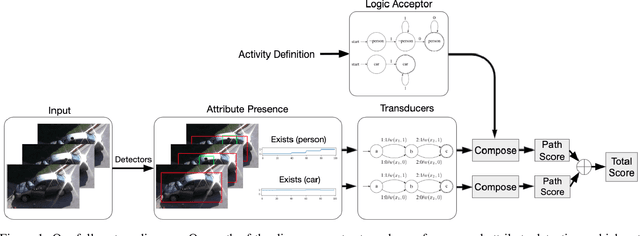
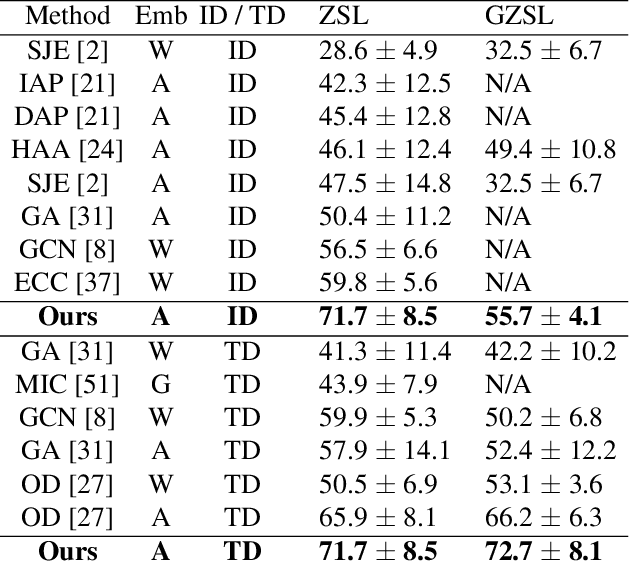
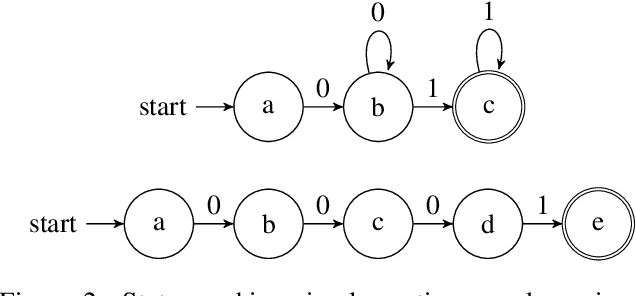

Abstract:Zero-shot video classification for fine-grained activity recognition has largely been explored using methods similar to its image-based counterpart, namely by defining image-derived attributes that serve to discriminate among classes. However, such methods do not capture the fundamental dynamics of activities and are thus limited to cases where static image content alone suffices to classify an activity. For example, reversible actions such as entering and exiting a car are often indistinguishable. In this work, we present a framework for straightforward modeling of activities as a state machine of dynamic attributes. We show that encoding the temporal structure of attributes greatly increases our modeling power, allowing us to capture action direction, for example. Further, we can extend this to activity detection using dynamic programming, providing, to our knowledge, the first example of zero-shot joint segmentation and classification of complex action sequences in a larger video. We evaluate our method on the Olympic Sports dataset where our model establishes a new state of the art for standard zero-shot-learning (ZSL) evaluation as well as outperforming all other models in the inductive category for general (GZSL) zero-shot evaluation. Additionally, we are the first to demonstrate zero-shot decoding of complex action sequences on a widely used surgical dataset. Lastly, we show that that we can even eliminate the need to train attribute detectors by using off-the-shelf object detectors to recognize activities in challenging surveillance videos.
A Unified Framework for Multi-View Multi-Class Object Pose Estimation
Oct 06, 2018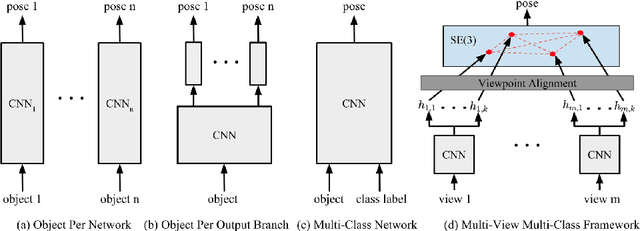

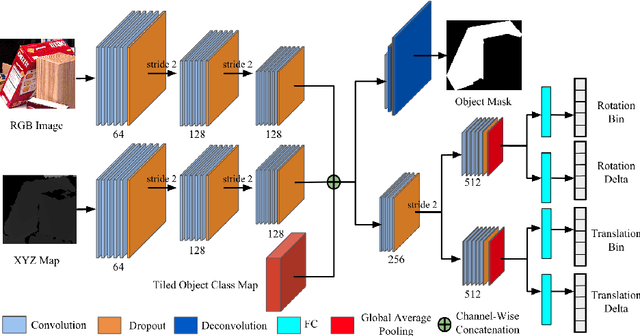

Abstract:One core challenge in object pose estimation is to ensure accurate and robust performance for large numbers of diverse foreground objects amidst complex background clutter. In this work, we present a scalable framework for accurately inferring six Degree-of-Freedom (6-DoF) pose for a large number of object classes from single or multiple views. To learn discriminative pose features, we integrate three new capabilities into a deep Convolutional Neural Network (CNN): an inference scheme that combines both classification and pose regression based on a uniform tessellation of the Special Euclidean group in three dimensions (SE(3)), the fusion of class priors into the training process via a tiled class map, and an additional regularization using deep supervision with an object mask. Further, an efficient multi-view framework is formulated to address single-view ambiguity. We show that this framework consistently improves the performance of the single-view network. We evaluate our method on three large-scale benchmarks: YCB-Video, JHUScene-50 and ObjectNet-3D. Our approach achieves competitive or superior performance over the current state-of-the-art methods.
 Add to Chrome
Add to Chrome Add to Firefox
Add to Firefox Add to Edge
Add to Edge